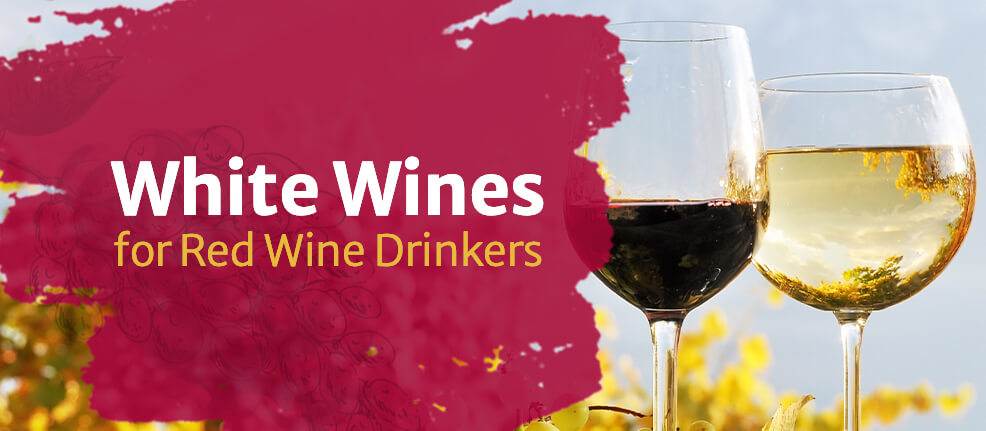
Wine drinkers overwhelmingly fall into one of two categories: red wine drinkers and white wine drinkers. The white wine enthusiasts can’t imagine enjoying the taste of a savory, dry red. Red wine drinkers can’t imagine buying a bottle of fruity, light white. While these two groups may not often mix, we’re going to shatter the stereotype by giving you some food for thought. We’re going to suggest white wines for red wine drinkers.
A recent national survey showed that 57.8 percent of Americans prefer red wine to white wine. There are several white wines that have a depth of taste more like a red, so if given a chance, you may discover there are some white wines that — dare we say it? — you might truly enjoy. You can’t deny the fact that a glass of white is known for being lighter, more refreshing and more versatile when it comes to food pairings. Plus, the high-end white wines are often much more affordable than a high-end bottle of red.
With summer just around the corner, why not try one of these white wines for red wine lovers?
To help you choose a white wine, we’ve matched some of the most popular reds with a white that has a similar flavor profile. We’ve also included a few whites that are usually good matches for red wine drinkers, regardless of your specific red wine preference.
Pinot Noir or Cabernet: Chardonnay
Fun fact: pinot noir grapes and chardonnay grapes are often grown together, either on the same vineyard or in the same region. Just like a pinot noir comes in several different styles, so does a chardonnay. The full-bodied cabernet drinker can also often enjoy the full-bodied chardonnay. If you haven’t tried a chardonnay that you like, it could be that you weren’t drinking a variety of the wine that matches your pinot noir or cabernet preference.
Here’s some background information that can help you choose the chardonnay pair to your pinot noir or cabernet favorite.
In general, chardonnay grows best in cooler climates, but it’s also successful in warmer climates that tend to have morning fog. As a wine drinker, you know that different climates produce different tastes. In general, the cooler climates — like Oregon, Burgundy and Chile — produce wine with savory fruit flavors, like lemon, quince and apple. The warmer climates — like the California coastal regions — produce wine with sweet fruit flavors like mango and pineapple.
If you’re a big fan of the light, fresh, earthy characteristics of pinot noir, consider trying a white burgundy. If, on the other hand, you prefer the fruitier style of pinot noir, you should consider a California chardonnay with rich, buttery and vanilla oak flavors.
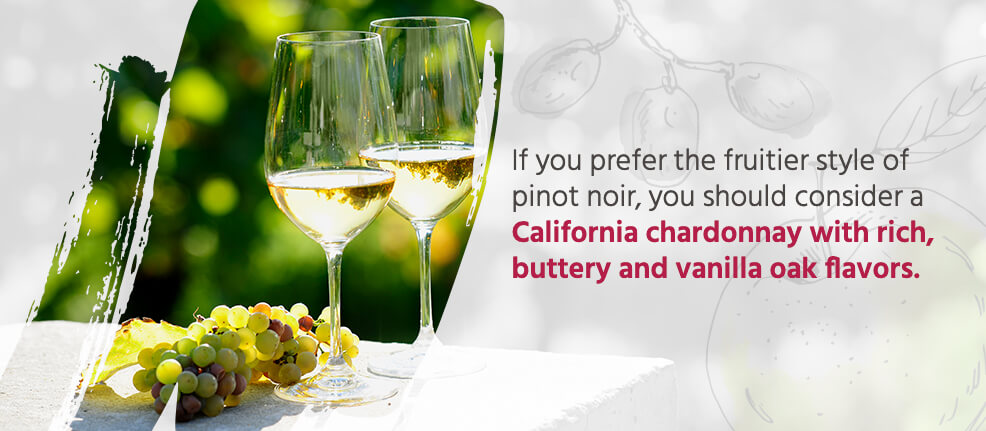
If you prefer a full-bodied cabernet, you’ll be happy to know there are also full-bodied chardonnays. This type of chardonnay will be aged in oak via the malolactic process — something you’ll want to look for as you search for chardonnay to match your love of cabernet. These full-bodied white wines will give you toasty notes of vanilla and cream.
Cabernet Sauvignon or Merlot: Sauvignon Blanc
While cabernet sauvignon and merlot come from two separate grapes, these grapes are from the same Bordeaux grape family, which means they share some of the same characteristics. A few varieties of sauvignon blanc are hands-down the best white wine for you if you like a more herbal and savory flavor.
The grapes used to make cabernet sauvignon and merlot have something in common with a white wine relative that comes from the same bordeaux family: sauvignon blanc. That doesn’t mean all sauvignon blanc wines are a good match for red wine drinkers though. Again, the region of the grapes plays a role. In this case, California winemakers are responsible for making richer varieties of this white wine that is more likely to appeal to cabernet sauvignon and merlot drinkers.
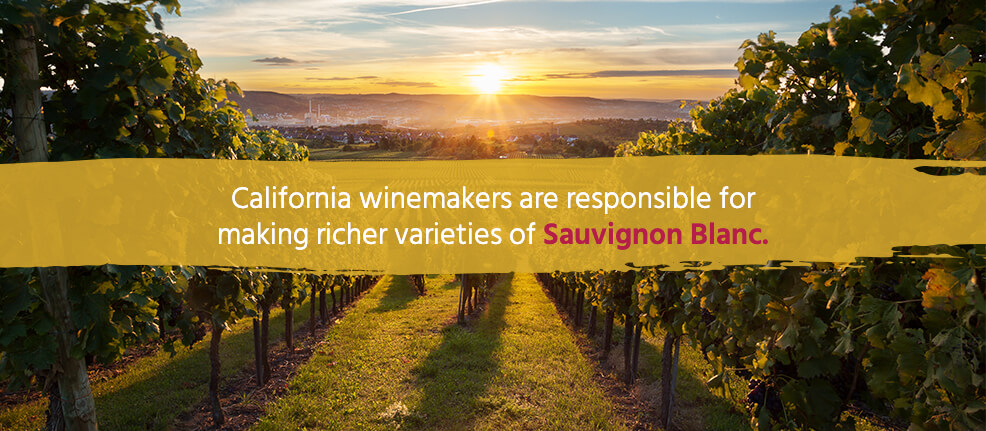
Better yet, take a rich sauvignon blanc and combine it with semillon. These are white grapes known for being a rich and full-weighted variety, mostly found in France and Australia. Semillon-sauvignon blanc isn’t the most common. In fact, one of the most expensive white wines in the world, Chateau Haut-Brion Blanc, is this very blend. But have no fear — there are winemakers in Sonoma, Napa and Washington State that create plenty of more affordable options.
Rioja or Tempranillo: Rhone Whites
The region where the grapes are grown is also the primary reason people who prefer rioja or tempranillo wines may find their ideal white wine pair has roots in Rhone. As many red wine drinkers know, rioja is frequently recognized as the most famous Spanish wine. Unlike many grape varieties, which originate in one region but are then transposed to new growing areas around the world, the tempranillo grapes have always been born and raised in Spain — and used in wine for over 2,000 years. Rioja wines use a blend of grapes, with the tempranillo group being the primary variety, and are named (as most wines are) for the region of Spain in which they’re grown.
If you can sacrifice your Spanish wine pride, you may find a white wine pair in France. Viognier, marsanne and roussanne are all varieties from the Rhone Valley of France that may appeal to you. Viogniers may have a slightly familiar taste, as these grapes are often used to blend into red wines to give them complexity. Who knew a white grape could be responsible for adding such complexity?
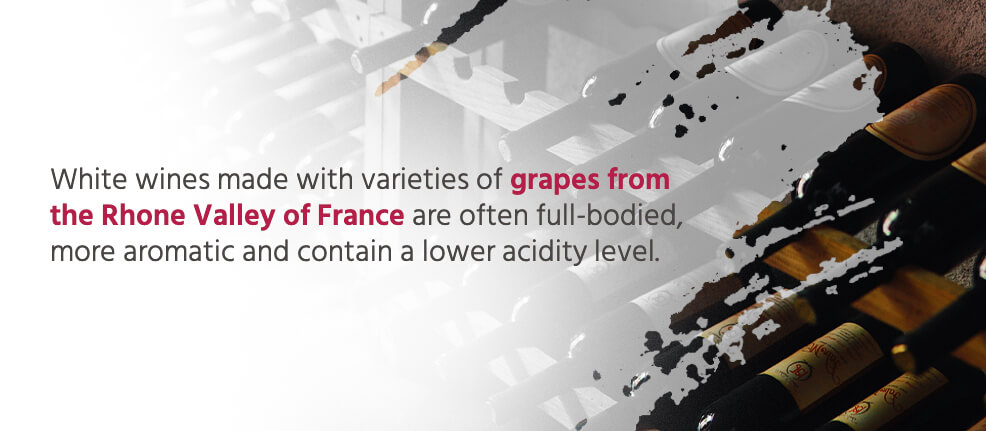
White wines made with varieties of grapes from the Rhone Valley of France are often full-bodied, more aromatic and contain a lower acidity level. You’ll discover flavors of ripe stone fruit, spice and herb with floral aromas. If you’re searching for a domestic producer, look no further than California’s Central Coast.
Marsanne-roussanne is a combination of two white grapes originally from the Rhone Valley that are now growing in California’s Central Coast and Washington State. In these white wines, you’ll find flavors of baked apple, lemon, tangerine, beeswax and — when aged in oak — a rich, full-bodied, oily texture. These and other Rhone Whites are great white wines for red wine drinkers.
Malbec: Portuguese Whites
If you’re in love with the lush fruit, full body, easy drinking and elevated body and alcohol of a malbec, you’re sure to love Portuguese whites. Part of what is responsible for the malbec experience is that it’s from the hot climate of Argentina. To get a white that tempts your palate, you’re going to want one from the central and southern parts of Portugal, where the grapes are fully ripened. These grapes result in a bold, full-fruited wine that somehow still manages to be refreshing.
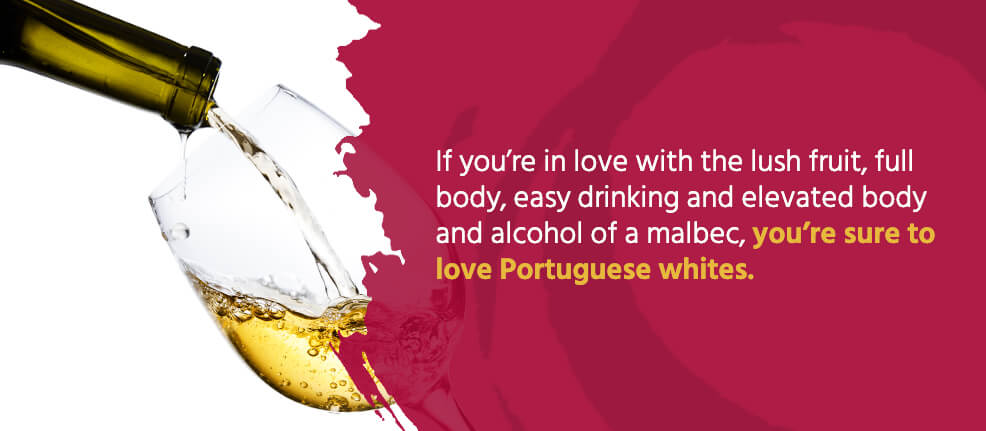
Which Portuguese white wines could be best? Arinto, encruzado and antão vaz are three great options. Encruzado wines are from the Dao region in the north and branco blends from inland Alentejo are also a great match. These grapes have a naturally higher acidity, so as a red wine drinker, look for an older variety to capitalize on the nutty and lush flavors.
Italian Reds: Savennieres
We’re aware that not all Italian reds are created equal. In fact, quite the opposite — within this group is a wide range of styles. However, believe it or not, there are some things they have in common, including body, tannic structure and acidity. Yes, Italian whites are a thing — and for some who love Italian reds, that might be enough. But there are other whites with similar characteristics we think red wine drinkers might like even better.
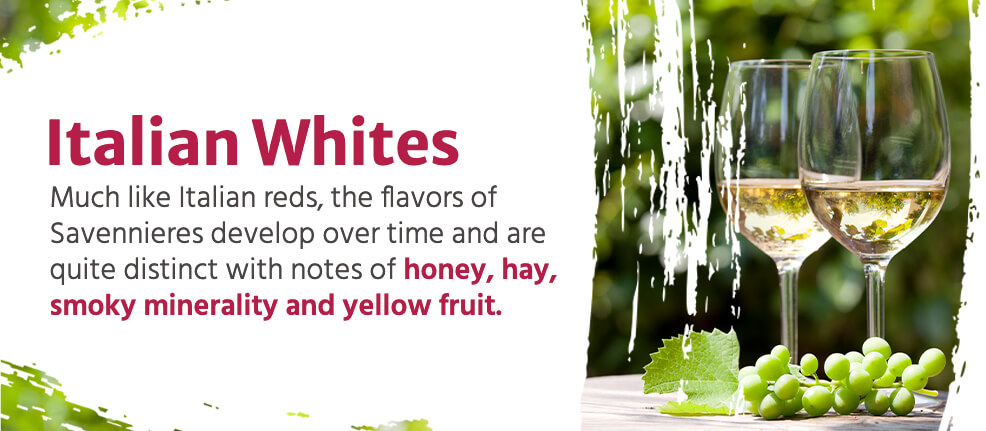
We’re talking about a unique style of chenin blanc, called savennieres, that originate in the Loire Valley of France. In this region of France, grapes are left to ripen as long as possible, being harvested late and fermented dry. This method produces a full-bodied, complex wine that has the high acidity of a chenin blanc. Much like Italian reds, the flavors of Savennieres develop over time and are quite distinct with notes of honey, hay, smoky minerality and yellow fruit. Giving it time to age only makes the flavor better for red wine drinkers.
Fun and Funky Reds: Orange Wine
Orange wine is related to red wine in a different way. The colors are similar, certainly, but so is the winemaking process. Like the reds, during fermentation, the grape skins remain in contact with the juice. This means the natural tannins of the grape skins and seeds come out in the wine, creating that drying sensation and adding a depth of flavor that’s usually only found in red wines. Production of these orange wines is ancient but has begun to resurface, primarily in Slovenia and northeastern Italy.
Many orange wines also incorporate oxidation. Before you jump to negative conclusions, hear us out. It’s true that an overabundance of oxygen can be a bad thing for wine flavors. However, in orange wines, it serves a purpose that can be appealing to red wine drinkers: it softens the fruity flavors and acidity levels and allows the wine to develop more complex flavors. The result from these oxidated orange wines is a nutty flavor that appeals to many red wine drinkers.
Overall, you won’t find any overriding fruit flavors in these wines. Instead, you’ll notice the fermented and aging flavors like brazil nut, wood varnish, linseed oil and sourdough.
Others: Ribolla Gialla, Rioja Blanco, Assyrtiko
Ribolla — also known as rebula — gialla is a very rich white wine from the northeastern parts of Italy that has a full body and is packed with baked apple and tangerine flavors. You’ll also likely taste hints of honey, Thyme and roasted nut. Choose from fresh and aged styles as well as a more “orange” style — all white wines worth exploring for red wine drinkers.
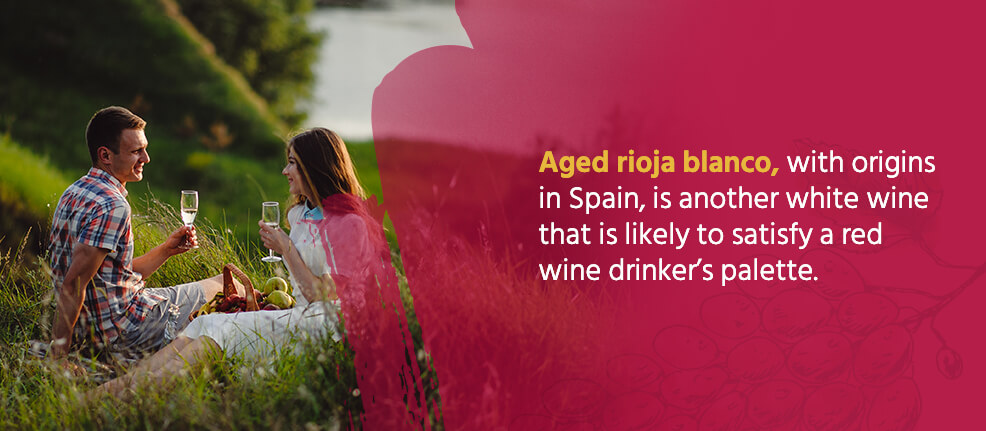
Aged rioja blanco, with origins in Spain, is another white wine that is likely to satisfy a red wine drinker’s palette. As it ages, it takes on a beautiful gold color and produces more nutty and tertiary flavors with notes of petrol, beeswax, chamomile and subtle citrus flavors. This is a wine you’ll love the longer it’s in the bottle.
Travel to Greece, an area not known for its wine, and you’ll find assyrtiko grapes. If you’ve heard of wine from Greece, chances are good it’s made with assyrtiko grapes. These grapes grow on an island, and when you taste the very best versions of it, you’ll be able to tell that it comes from a location near the ocean. In assyrtiko wine, you’ll uncover flavors of briny salinity, chalky minerals and aromas of seaspray. It’s a complex flavor profile that’s different and appeals to many red wine drinkers.
White Wine That Tastes Like Red Wine
If you’re in search of a white wine that tastes like a red, there are a few overall tips to follow. They start with answering a simple question: what is it about white wines that red wine drinkers seem to dislike? We’re sure your answers are likely to be one or more of the following:
- White wines are too sweet or too fruity.
- White wines are too light. They don’t have the depth of taste that reds do.
- White wines are too acidic or too tart.
Therefore, it makes sense that if you’re searching for a white wine you’ll like, you should be searching for a white wine that has a full body, more texture, low acidity and has been aged in oak and perhaps even oxidized. We know these words and phrases may be familiar to a seasoned wine drinker, but for those who may not consider themselves to be a wine connoisseur, what exactly do each of these mean? We’ve included some background information on each:
1. “Full Body”
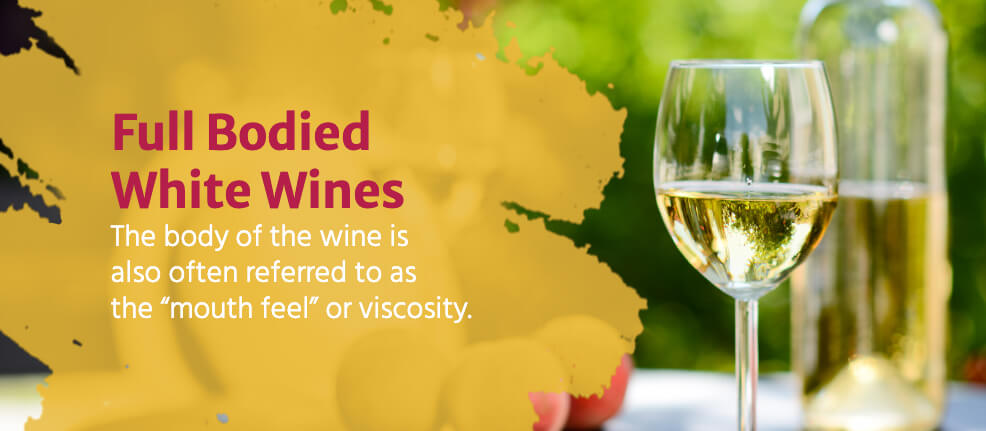
The body of the wine is also often referred to as the “mouth feel” or viscosity. How heavy or light does the wine feel in your mouth? If you’re a fan of red wines, chances are good you like a fuller-bodied wine, because reds tend to be heavier. Alcohol goes hand-in-hand with the body, so heavier wines also are usually more alcoholic. Fortunately, as we mentioned, there are several fuller-bodied white options — you just have to know where to look for them.
2. “More Texture”
The texture is closely tied to the body and alcohol of wine but takes it one step further. Instead of describing it as “heavy” or “light,” texture explores the specifics: creamy, smooth, velvety, oily, waxy, juicy and silky are all words you might use to describe the texture of a wine. They are all physical sensations you sense in your mouth when you drink the wine.
If your wine has a full body and higher alcohol content, it probably has a more complex texture, meaning there are more of these sensations or that the sensations are stronger. In red wines, some of the texture also comes from the tannins found in grape skins, seeds and stems. This natural compound has a bitter taste that is incorporated into the wine throughout the red winemaking process, which involves exposure to the grape skins, seeds and stems for an extended period.
White wines, on the other hand, have low tannins as a result of the winemaking process being different — that is, it does not incorporate the grape skins, seeds and stems in the process. The one exception is orange wine, which is why orange wines frequently appeal to red wine drinkers.
Since the texture is so closely related to body and alcohol content, it’s easy to see that this is another characteristic common in red wines that can be found in whites.
3. “Aged in Oak”
Barrel tannins exist and can be extracted from the oak. If you have white wine, it likely won’t get the tannins from the winemaking process. However, if it’s aged in oak barrels, the amount of tannin will be increased. There are red wines aged in oak as well, so you may notice a familiar taste. We should point out that the tannins found in grape skins and oak barrels are different — the tannins that come from oak are more subtle. However, it still adds to the texture of the wine, which is something red wine drinkers are looking for in a white wine.
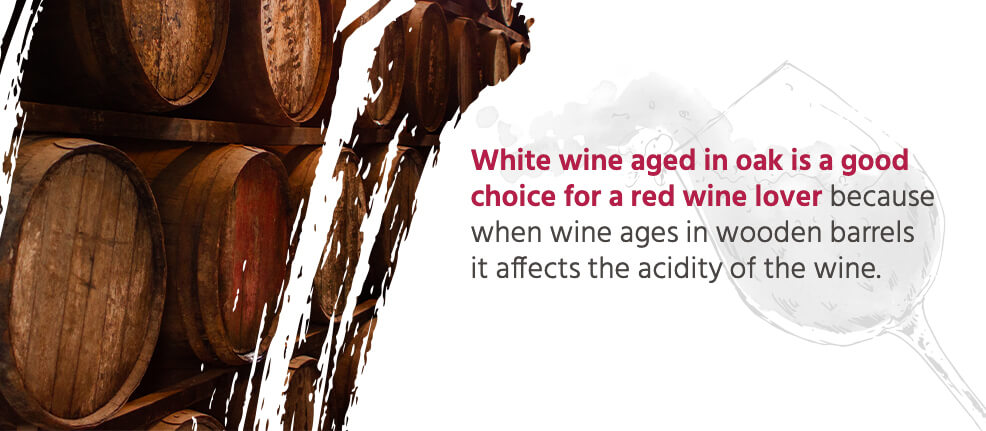
Another reason why a white wine aged in oak is a good choice for a red wine lover is that when wines age in wooden barrels, a process known as malolactic fermentation usually occurs, which affects the acidity of the wine.
4. “Low Acidity”
Nearly all red wines have a lower acidity level as a result of going through the malolactic fermentation process. Technically this isn’t fermentation at all, since it doesn’t use yeast. Instead, through this process, bacteria change the acid in wine from malic acid, which has a tart taste, into lactic acid.
What that means for you is less of the tart taste you may associate with white wines and more of a soft, creamy acid that’s more like milk. Since this is a process the overwhelming majority of red wines go through, this lower acidity and the taste that comes with it usually appeals more to red wine drinkers. However, there are some white wines, like chardonnay and viognier, that go through the same process and, therefore, often appeal to red wine drinkers.
5. “Oxidized”
We know the sight of this word makes many wine enthusiasts cringe. “Oxidation” is the word many of us use to describe the tragic deterioration of wine as a result of exposure to too much oxygen over time. Think of a faulty cork or one that hasn’t been tightly secured. However, the reality is that oxygen plays a key role in the winemaking process. Yes, there is absolutely a sweet spot for the amount that is used. And yes, oxidation is still the word used to describe the “blah” bottle of wine you are left with after realizing you had a cracked cork.
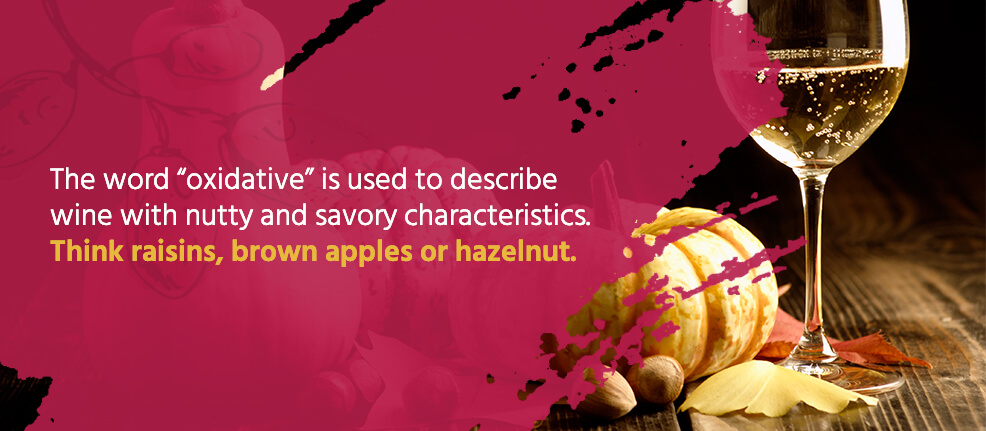
Overall, the word “oxidative” is used to describe wine with nutty and savory characteristics. Think raisins, brown apples or hazelnut. These are flavors that red wine drinkers love and which are developed through exposure to some air in a barrel — another benefit that can correlate to aging in oak barrels. To prove just how much of a good thing oxidation can be, the word “oxidized” was named Bon Appetit’s Wine Word of 2017.
Shop for White and Red Wines Online
Whether we’ve convinced you, as a red wine drinker, to give white wines a try or not, Marketview Liquor has a wide selection of both white wines and red wines that are easy to order online by the bottle or the case and have shipped anywhere in the United States. The best part is that you can choose from select bottles of wine and mix and match a customized case of wine that includes your favorite reds and their white wine partners.
With our extensive online selection, you’re sure to find the wine you want in a price range that will please you. Choose from wines that originate along California’s central coast, in the valleys of France, on the rolling hills of Spain or an island in Greece. Whether you’re searching for a high-end bottle to give as a gift or a case of affordable favorites to stock your pantry, our selection includes them all.
Get started by searching for your perfect white wine pair — or your tried-and-true red wine — on our website.
